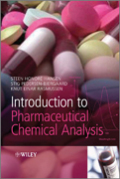
Introduction to pharmaceutical chemical analysis
Hansen, Steen
Pedersen-Bjergaard, Stig
Rasmussen, Knut
This textbook is the first to present a systematic introduction to chemical analysis of pharmaceutical raw materials, finished pharmaceutical products, andof drugs in biological fluids, which are carried out in pharmaceutical laboratories worldwide. In addition, this textbook teaches the fundamentals of all the major analytical techniques used in the pharmaceutical laboratory, and teaches the international pharmacopoeias and guidelines of importance for the field. It is primarily intended for the pharmacy student, to teach the requirements in analytical chemistry for the 5 years pharmacy curriculum, but the textbook is also intended for analytical chemists moving into the field of pharmaceutical analysis. Addresses the basic concepts, then establishes the foundations for the common analytical methods that are currently used in the quantitative and qualitative chemical analysis of pharmaceutical drugs Provides an understanding of common analytical techniques used in all areas of pharmaceutical development Suitable for a foundation course in chemical and pharmaceutical sciences Aimed at undergraduate students of degrees in Pharmaceutical Science/Chemistry Analytical Science/Chemistry, Forensic analysis Includes many illustrativeexamples INDICE: Preface xv 1 Introduction to Pharmaceutical Analysis 1 1.1 Applications and Definitions 1 1.2 The Life of Medicines 4 1.3 The Quality of MedicalProducts 8 1.4 Summary 11 2 International Pharmacopoeias, Regulations and Guidelines 13 2.1 Overview of Legislation 13 2.2 Legislation and Regulations for Industrial Production 14 2.3 Life Time of Drugs and Drug Substances 17 2.4 Pharmacopoeias 18 2.5 International Harmonization 19 2.5.1 International Conference on Harmonization 20 2.5.2 Pharmacopoeial Discussion Group 20 2.6 Legislation and Regulations for Pharmacy Production 20 2.7 Summary 21 3 Fundamental Chemical Properties, Buffers and pH 23 3.1 pH and pKa 23 3.2 Partition 25 3.3 Stereochemistry 28 3.4 Stability Testing 29 3.5 Summary 30 4 Fundamentals of Pharmaceutical Analysis 33 4.1 What is a Pharmaceutical (Chemical) Analysis? 33 4.2How to Specify Quantities and Concentrations? 35 4.3 Basic Laboratory Equipment 37 4.3.1 The Analytical Balance 37 4.3.2 Pipettes 41 4.3.3 Volumetric Flasks 44 4.3.4 Burettes 47 4.4 How to Make Solutions and Dilutions 47 4.5 Calibration of Analytical Methods 49 4.6 Errors, Accuracy, and Precision 50 4.6.1 Systematic and Random Errors 50 4.6.2 Accuracy and Precision 51 4.7 Statistics 52 4.7.1 Mean Value and Standard Deviation 52 4.7.2 Confidence Intervals 54 4.7.3Comparison of Means with a t-Test 55 4.7.4 Q-Test to Reject Outliers 56 4.7.5Linear Regression with the Method of Least Squares 57 4.7.6 How to Present anAnalytical Result 58 4.8 Some Words and Concepts 62 4.8.1 Analysis and Determination 62 4.8.2 Sample Replicates and Measuring Replicates 62 4.8.3 Interference 62 4.8.4 Blind Samples 62 5 Titrimetric Methods 65 5.1 Introduction 65 5.2AcidBase Titrations 72 5.3 AcidBase Titrations in Non-Aqueous Media 75 5.4 Redox Titrations 78 5.5 Other Principles of Titration 81 5.6 Summary 82 6 Introduction to Spectroscopic Methods 83 6.1 Electromagnetic Radiation 83 6.2 Molecules and Electromagnetic Radiation 85 6.3 Atoms and Electromagnetic Radiation 86 6.4 Summary 88 7 UV Spectrophotometry 89 7.1 Principle of Quantitative Determination 89 7.2 Principle of Identification 94 7.3 Which Substances Have Strong UV Absorbance? 95 7.4 Instrumentation 95 7.5 Practical Work and Method Development 99 7.6 Areas of Usage and Performance 101 7.7 System Testing 101 7.8 Summary 102 8 IR Spectrophotometry 103 8.1 IR Spectrophotometry 103 8.2 Instrumentation 106 8.3 Scope 109 8.4 Instrument Calibration 109 8.5 NIR Spectrophotometry 110 8.6 Applications 112 8.7 Summary 114 9 Atomic Spectrometry 115 9.1 Atomic Absorption Spectrometry 115 9.2 Instrumentation 118 9.3 Applications and Performance 121 9.4 Practical Work and Method Development 122 9.5 Atomic Emission Spectrometry 123 9.6 Instrumentation 124 9.7 Summary 124 10 Chromatography127 10.1 General Principles 127
- ISBN: 978-0-470-66122-2
- Editorial: John Wiley & Sons
- Encuadernacion: Rústica
- Páginas: 512
- Fecha Publicación: 16/12/2011
- Nº Volúmenes: 1
- Idioma: Inglés
